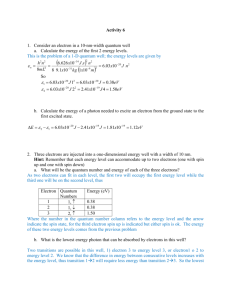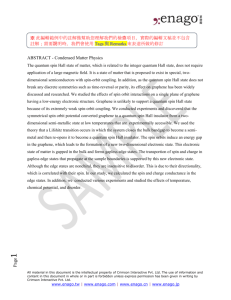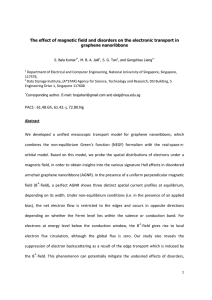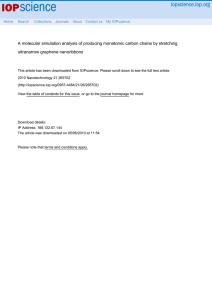SM+ - AIP FTP Server
advertisement
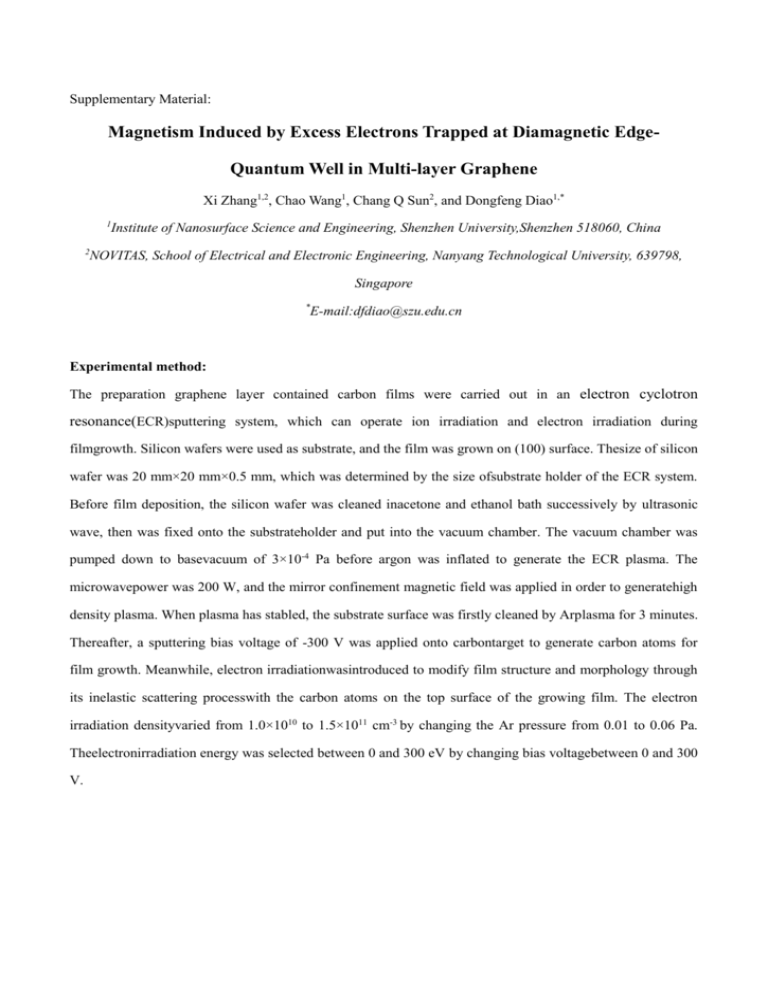
Supplementary Material: Magnetism Induced by Excess Electrons Trapped at Diamagnetic EdgeQuantum Well in Multi-layer Graphene Xi Zhang1,2, Chao Wang1, Chang Q Sun2, and Dongfeng Diao1,* 1 Institute of Nanosurface Science and Engineering, Shenzhen University,Shenzhen 518060, China 2 NOVITAS, School of Electrical and Electronic Engineering, Nanyang Technological University, 639798, Singapore * E-mail:dfdiao@szu.edu.cn Experimental method: The preparation graphene layer contained carbon films were carried out in an electron cyclotron resonance(ECR)sputtering system, which can operate ion irradiation and electron irradiation during filmgrowth. Silicon wafers were used as substrate, and the film was grown on (100) surface. Thesize of silicon wafer was 20 mm×20 mm×0.5 mm, which was determined by the size ofsubstrate holder of the ECR system. Before film deposition, the silicon wafer was cleaned inacetone and ethanol bath successively by ultrasonic wave, then was fixed onto the substrateholder and put into the vacuum chamber. The vacuum chamber was pumped down to basevacuum of 3×10-4 Pa before argon was inflated to generate the ECR plasma. The microwavepower was 200 W, and the mirror confinement magnetic field was applied in order to generatehigh density plasma. When plasma has stabled, the substrate surface was firstly cleaned by Arplasma for 3 minutes. Thereafter, a sputtering bias voltage of -300 V was applied onto carbontarget to generate carbon atoms for film growth. Meanwhile, electron irradiationwasintroduced to modify film structure and morphology through its inelastic scattering processwith the carbon atoms on the top surface of the growing film. The electron irradiation densityvaried from 1.0×1010 to 1.5×1011 cm-3 by changing the Ar pressure from 0.01 to 0.06 Pa. Theelectronirradiation energy was selected between 0 and 300 eV by changing bias voltagebetween 0 and 300 V. Fig. S1 Spin density distribution of monolayer armchair graphene nanoribbon (AGNR) induced by excess electrons (e= 1) in a unit cell.Spin density mainly shows at edge sites. The special atomic positions (C1, C2 and Center) are labeled. Fig. S2 Spin density distribution of bilayer AGNR induced by excess electrons (e= 2). Fig. S3 Large amount of excess electrons (e= 4) induces structural distortion in front view (left) and side view (right) of trilayer AGNR. The repulsive force among excess electrons increases the inter-layer distance from ~3.8 to ~4.2 in center and further to ~5.0 at edge. Inter-layer lattice mismatch is induced as well. Charge (a) spin (b) 0.00 C2 -0.05 C2 Center -0.10 -0.15 0.10 0.08 0.06 0.04 0.02 0.00 C1 C1 C1 C1 C2 0 C2 Center 4 8 12 16 20 Atomic position Fig. S4The profiles of Mulliken charge(a) and spin(b) along the ribbon width direction in monolayer AGNR at e(excess)= -1. Negative charge sign means electron gain. The bond length at C1 site decreases from 0.1420nm in graphite to 0.1257nm (by -11.5%), and C-C bond at C2 site expands slightly to 0.1426nm (by 0.4%). Charge (a) Spin (b) 0.2 0.1 0.0 -0.1 -0.2 -0.3 -0.4 -0.5 0.30 0.25 0.20 0.15 0.10 0.05 0.00 2 1 0 I1 -1 -2 -3 -4 -5 -2 -3 -1 C1 C2 Center C2 C1 Special Position Fig. S5The Mulliken charge (a) and spin (b) of monolayer AGNR at special atomic sites (C1, C2 and Center) of different e(excess). (a) 0.06 Charge 0.00 -0.06 0 -1 -2 -3 -0.12 -0.18 -3 0.08 -2 Spin (b) 0.12 0.04 0.00 Special Position Fig. S6 The Mulliken charge (a) and spin (b) in the outside layer of trilayer AGNR at special atomic sites.




